It's a Mod, Mod, Mod (Guitar) World
Talking guitar modifications and new Fender axes with Justin Norvell
Greetings, Jagged Time Lapsers!
As many of you know, I love musical instruments almost as much as I love music — and this post is for those of you who feel the same way…
One Saturday morning forty-two years ago this month, I walked up Clark Street past Chicago’s legendary Weiners Circle and into Clark Pawners. I was accompanied by my mom, who handed the proprietor eighty bucks in exchange for the little red and black electric six-string hanging from the wall behind the counter. It was my first guitar — and while it was by no means a great or even good one, in the grand scheme of things I don’t think I’ve ever received a more important birthday present. (Thanks again, Mom!)
I knew next to nothing about guitars at that point; all I knew was that strumming a tennis racket along to my favorite records was no longer cutting it, and I was itching to make some real rock n’ roll noise of my own. And noise was about all I did make with my new axe — an unbranded Korean hardtail Strat cousin with a 3/4 neck and two single-coil pickups — at least for a few months, until my friend (and future Lava Sutra bandmate) Jason showed me a few open chords, lent me his Beatles and Bruce Springsteen songbooks, and sent me on my merry way into an obsession that has lasted to this day.
But even as I was still fumbling with my first D-G-A progression, I was totally fascinated by the different noises my guitar could make while plugged into my Panasonic Platinum boombox via a Radio Shack stereo preamp, a jerry-rigged setup which served as my “guitar amplifier” for a year until I got myself a Peavey Backstage 20. I would often stick things between the strings — paper, pens, a screwdriver — just to see what kind of tones would result.
Once, after removing the pick guard to get a look “under the hood,” I noticed an empty cavity in the guitar’s body, which I proceeded to fill up with screws, nails, hooks and other stray bits of metal from the family toolbox, thinking that this might somehow make for a crunchier, more metallic sound. You will be unsurprised to learn that a) my experiment only resulted in the guitar rattling like an industrial maraca whenever I played it, and b) I knew absolutely nothing about electronics.
Hungry to learn more about guitars and unravel their tonal mysteries, I started picking up issues of Guitar Player and Guitar World magazines, having no idea that I would someday be writing for both of them. This was where I discovered that, for many guitarists — even top-of-the-heap axe slingers like Eddie Van Halen, Mark Knopfler, Billy Gibbons and Stevie Ray Vaughan — the search for the perfect tone was never-ending, and that said quest often involved making additional modifications to perfectly serviceable instruments. I was intrigued… but after a rather ham-fisted attempt at replacing the stock tuners on my second guitar (a reddish-orange Peavey T-15) with some Grovers, I quickly came to the realization that I was not cut out to implement such mods on my own. To date, outfitting a guitar with a custom pick guard is about as much as I’ve ever been able to handle.
Through the years, I’ve mostly adopted a “don’t fix if it ain’t broke” policy with my guitars. The Japanese-made 1997 Fender Telecaster above (nicknamed “Pinky” for obvious reasons) is actually the most modded-out guitar I’ve ever owned. Along with the self-installed psychedelic pick guard — a 2019 present from my buddy Mike at Truetone Music in Santa Monica — I had its original pickups replaced in the late nineties with Seymour Duncan Antiquities (to give it a more vintage 1950s bite), and the repair guy who did that job also replaced its original three-way toggle switch with a four-position one, rewiring the guitar to give it a beefier sound when both pickups are engaged.
Since then, I’ve largely let Pinky be… though I’m well aware that there are many other and considerably more drastic changes/upgrades I could make to it if I cared to. Ditto for the Squier Classic Vibe ‘50s Stratocaster to its left; other than having the tremolo “decked” (I’ve honestly never been a big fan of Strat tremolos), I absolutely love it just as it is. Even so, online guitar forums are jammed with posts praising this affordable model (Squier is Fender’s budget-friendly subsidiary) as “a great cheap mod platform,” and detailing the countless DIY modification options available to improve its sound, playability and/or appearance.
Fender guitars in general have long been a popular platform for modification, something that’s clearly been taken into account in the creation of the company’s newly-launched Player II Modified collection, which takes Fender’s entry-level Player II guitars and basses — Telecasters, Stratocasters, “Super Strats,” Precision Basses and Jazz Basses — and hot-rods ‘em with an impressive array of upgraded electronics and hardware (such as Modified Noiseless pickups, master volume controls with “treble bleed” wiring, and locking tuners) and such tasty-looking new finishes as Sunshine Yellow, Electric Blue and Harvest Green Metallic.
Though I haven’t actually had a chance to play any of these guitars yet, I was definitely intrigued by the announcement of this new collection — and all the more so upon learning that British rockers IDLES are promoting it. IDLES guitarists Mark Bowen and Lee Kiernan are known for their uncompromising approach to sonic mayhem (as further evidenced by Kiernan’s truly bonkers Gary overdrive/fuzz pedal, which I recently covered for the EarthQuaker Devices blog); so if these particular axes meet their lofty standards, I figured they must be worth checking out…
And since I’m always up for shooting the guitar-geek breeze with kindred souls, I jumped at the opportunity to speak this past week with Justin Norvell, EVP of Product at Fender, about the creation of the company’s new line — a conversation which also delved into the long and glorious history of Fender players making sonic and aesthetic modifications to their guitars. As I happened to be wearing an MC5 shirt for my Zoom call with Justin, we started off talking about the late, great Brother Wayne Kramer and his legendary humbucker-outfitted, stars-and-stripes-painted Stratocaster. Highlights from our chat follow below…
ME: I’m not sure if Wayne was the first guitarist to put a humbucker in a Strat — but he had to be one of the first, right?
JUSTIN NORVELL: One of them, absolutely. And he put it in the middle, which is weird, because everybody puts it in the bridge.
I asked him once what the deal was with that, and he was like, “It made things louder.” I was like, “Okay, cool…”
I have that picture of him with it here on my office wall — I think that’s one of the most rock n’ roll photos ever taken. Fred’s on his knees, Rob’s lying down on the stage, and Wayne’s just sending it. [laughs] I love it!
The earliest rocker that I can think of who actively modified his store-bought axe would have been Eddie Cochran, who put a humbucker in his Gretsch. But is Jimi Hendrix generally considered the first guitarist to modify his Fender?
Yeah, though that’s just more in the flipping of it [playing a right-handed guitar left-handed] and stuff… I would say it’s around that era, which is what sparks the Wayne Kramer thing. But I think that the unique thing about Fender is, you know, it was kind of complex surgery to do modifications on any other type of guitar. And I think that wasn’t even an intended consequence — the Fender design was all about serviceability, not modification.
You’ve definitely got cosmetic modifications happening in the late sixties, like George Harrison’s “Rocky” Strat and stuff like that. But the seventies is when it really took off, when people really started kind of hacking things out of their guitars. They weren’t “vintage” guitars yet; they were just old guitars, and you could buy ‘em in pawn shops for $200 and just slap something else in it. Dave Murray from Iron Maiden had Paul Kossoff from Free’s old Strat, and ended up putting two humbuckers in it with a with a single coil in the middle. And the guitar that Kurt Cobain famously played — the double-humbucker Jaguar — was eventually traced back to Cliff Richard’s guitar player when he was in a disco phase.
Wow — I had no idea!
Yeah, it’s such an odd guitar. I know Ernie [Bailey], who was Kurt’s tech, and he’s like, “The guitar came in a road case, so it was somebody's. A lefty Jag with humbuckers? Someone should know whose this is.” And eventually someone found a video of it…
But, yeah, I think the modifications at first were very utilitarian, and then it became more of a a search for sonic uniqueness. David Gilmour, early on, put an XLR jack on the bottom of his black Strat for a direct signal…
And I think there’s a crowd-sourcing element to this; like, Strats originally came with a three-position switch, and it was the players who found the “in-between” positions that are now the hallmark of what a Strat sounds like — you know, the “Sultans of Swing” tone, or “All Along the Watchtower,” or Mike McCready on [Pearl Jam’s] “Yellow Ledbetter”. That sound was completely unintentional, but that was probably the first popular modification —people putting a five-way switch Strats to get those sounds. Otherwise, people were jamming things into the switch cavity to make it stick there.
Yeah — in one of the first interviews I ever read with Mark Knopfler when I was a kid, he was talking about taping the toggle switch in place so it wouldn’t move from that “in-between” position.
It’s like, distortion was an unintended consequence that turned out to be super musical in amplifiers, right? And the Stratocaster’s tremolo was supposed to make it sound like a classical player’s tremolo fingerstyle. And then you have Jimi Hendrix using the tremolo in the way he did, and then Tom Morello using it in a completely different way… I think that’s the beauty of it, that all these players were able to find sounds that weren’t intended, or things or features that weren’t intended, but which became useful and new.
And I think that these guitars we’re making now are a celebration of that kind of aesthetic. Some of it is just to make your guitar have more sounds; some of it’s to make it more stable; and some of it’s functional, and some of it is sonic. But I think there’s just this idea that a Fender Strat or Tele can be a lifetime guitar, something that can change and evolve with you over time — like David Gilmour’s black Strat, which had a maple neck, and then he later changed it to a rosewood neck. The guitar can modded and modded and modded as your needs and playing style change, but then you can have it easily restored to stock. And that’s just a beautiful thing that is largely unique to Fender.
Which was also a reason that Pete Townshend primarily played Fenders on The Who’s first US tour, as I recall — his guitar tech could take two smashed-up guitars and make a new one out of the wreckage, which you certainly couldn’t do with a Rickenbacker.
Yeah, it’s wild — Stevie Ray Vaughan’s guy was doing the same thing. Every night, Stevie would stand on his Strat, and he would throw it across the stage, and then it was just like, “Okay, how do I put this back together?” But it also was modified, because it was like, “How do I reinforce this thing and make it more stable?” He used a little wire shielding where the strings met the saddle, so he wouldn’t break as many strings.
But there were all these little tricks that everybody employed throughout time. So, again, the modifications have been functional, cosmetic, aesthetic, sonic… and that's why I think there’s a ongoing relevance [with Fender guitars]. They’re these guitars from the early fifties, but they can be reinvented ad infinitum. They’ve formed the soundtrack of your life, but you can also put them through ten pedals and get some weird sounds that make them completely new again.
And I think that, just understanding the Fender ecosystem, you can always go back. It's like, there are a ton of other types of guitars that were routed out for Floyd Rose tremolos or different pickups in the eighties, and it’s pretty hard to go back with them. Those are, I guess you’d say, “destructive edits”. [laughs] Whereas there’s a lot of levels of “undo” on a Fender, right?
What was the genesis of this Player II Modified line?
The Player II series is kind of a baseline — like, as you get into the Fender brands, we have Squier below it, and that’s kind of the beginner, budget brand. Player II is kind of the “You’ve arrived” level; this is a Fender, but it is very traditional in nature. So for Player II Modified, we take these models, and then we go, “Well, if we were to reinterpret them or upgrade them, what would we do?” We put different tuners on them. We upgrade the pickups. We go to a different kind of bridge saddles. And there’s an active pre-amp in the basses that’s all-new. It’s just like, “What’s possible in the Fenderverse?”
You mentioned “crowd-sourcing” earlier, which made me think of all the guitar forums I’ve seen where people are buzzing about what great mod platforms Squiers are and what you could/should do to upgrade them. Are you taking those kinds of conversations into account when deciding what kinds of upgrades to give the Player II Modified guitars?
Yeah — it’s kind of a combination of, “What are the most popular things that people ask for or talk about?” and “What’s the most popular aftermarket stuff that our dealers sell?” And then, “What are some of the things that maybe people aren’t aware of that are cool?” You know, like a “treble bleed” circuit is kind of inside baseball, but if you play enough and you go, “Man, when I roll my volume down, it’s like there’s a pillow on my speaker,” there’s ways around that. And that opens up the whole universe of wiring; there’s a lot you can do there.
But, yeah, it’s largely crowd-sourced. We listen. It goes back to Leo Fender. He was into western swing and Hawaiian music, but had a lot of artists coming by to get their their amps repaired and stuff, and he was just like, “What are you looking for? What do you want? What do you need?” The utilitarian, functional, elegant simplicity of Fender — it kind of embodies that spirit, you know? So I think the listening thing is just another thing that’s part of Fender still having ongoing relevance and not becoming a nostalgic relic. It’s not a lute, you know? [laughs]
And of course, the new line includes the HSS Strat, featuring the ever-popular humbucker in the bridge position. Talk a little about that, if you will…
That’s probably the king of all mods, putting a humbucker in a Stratocaster, because then it becomes kind of the most versatile, best-of-all-worlds guitar. And again, players were doing that since the sixties, as we've already established, but Fender itself didn't really start offering many Strats with humbuckers until the nineties — so for a long time it was a “player only” kind of thing. And there was finally a realization [at the company] that, you know, all these people are doing this; it should be able to come this way, too, and we don’t have to forsake the regular one. So I think offering both versions in the Player II Modified line is really an important thing to do.
How did IDLES get involved?
We always love sonically adventurous artists, and we were attuned to IDLES early. They’re rough on their gear, but they definitely also view it as, “it’s a screwdriver, it's a hammer” — they're not precious about it. And they want what they want; the idea of locking tuners makes a lot of sense when you see them jumping around and thrashing about; and for them to have different types of pickups for more sonic variety, that makes sense as well. So the idea of them kind of being at the front of this campaign as the kind of representative band, it just made a lot of sense to us. Because musically, they’re kind of a collage of multiple different things; and the way these guitars are modified, their music is modified in a similar way.
And having them rep the line is a much different vibe than, say, having a —
Bluesman?
Hahaha, bingo!
Yeah, which I think would be a little more classic. With these guitars, it’s like, “We’re going to take these platforms and we’re going to modify them.” It’s a little less traditional or classic or precious. So we wanted to find someone that was like, “Yeah, give me the one in green that’s got the humbuckers slammed in it!”
Or the black Tele with the humbucker in the neck.
Which looks black, but it’s actually kind of got slight purple undertones to it; it’s really cool. I just think IDLES and this collection is a beautiful pairing — you know, like the wine goes with the chicken! [laughs] It kind of just kicks the door in a little bit to announce that it’s here, and you can do what you want with it…
Leo Fender said, “If I had $100 to build something, I'd spend $99 making it work and $1 making it pretty.” And amazingly, the Fender guitar is still lauded for its beauty and its elegance and its design, and the use of Danish curves and French curves in its kind of sensibility. However, they’ve always been built to be tools, built to be used, built to be modified, hacked up, whatever, and we’re just responding to and tipping the hat to the community of our players that love that stuff.
You mention the Danish curves — it took me a while to put it together, but now I can see how those classic Fender body designs really came out of that whole mid-century modern aesthetic.
A hundred percent! Even the Jazzmaster and Jaguar are like fins of cars, using those pastel car colors and all of those things. The idea of guitars back then were luthier-y arch tops, and they were built like violins; and these Fender guitars were planks of wood that were screwed together with plastic on them, or Bakelite at the time. It was seen as perhaps crude, or whatever; there was almost a little light ridicule from the guitar community because, you know, Geppetto was not rasping the tops of these things and blowing the dust off them. [laughs] It really was a Henry Ford-ization of the guitar, but in a way that was elegant and beautiful.
But again, the Telecaster was kind of squared off plank; it had a cutaway, but that was so you could play up high. And the Stratocaster, for all its beauty, was like, “Hey, these harder corners hit my arm funny, and it digs into my ribs.” The evolution of the shape of the guitars was truly from feedback, and based upon ergonomics and the things that were being learned. And so the ability to combine beauty and design with functionality, it’s really Dieter Rams kind of stuff.
Will the Jaguar and Jazzmaster be getting a Player II Modified makeover, as well?
That’s definitely in the discussion phase. If we’re talking about mods, those guitars are really like a playground — they’re like the Patient Zero for the modding culture, especially because those guitars were out of favor for so long and could be found so effortlessly. Which is why you had Tom Verlaine and Elvis Costello playing them in the punk era, and everyone playing them in the grunge era; J. Mascis famously went to buy a Strat, and the guy kind of bait and switched him on the price, so he had to buy the Jazzmaster because that’s what he could afford. So yeah, they lend themselves to it, and I think that it is a total possibility. But first, you know, we wanted to just go with the major food groups.
You may also dig…


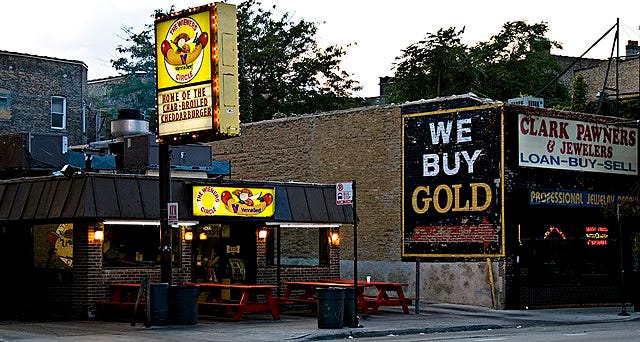
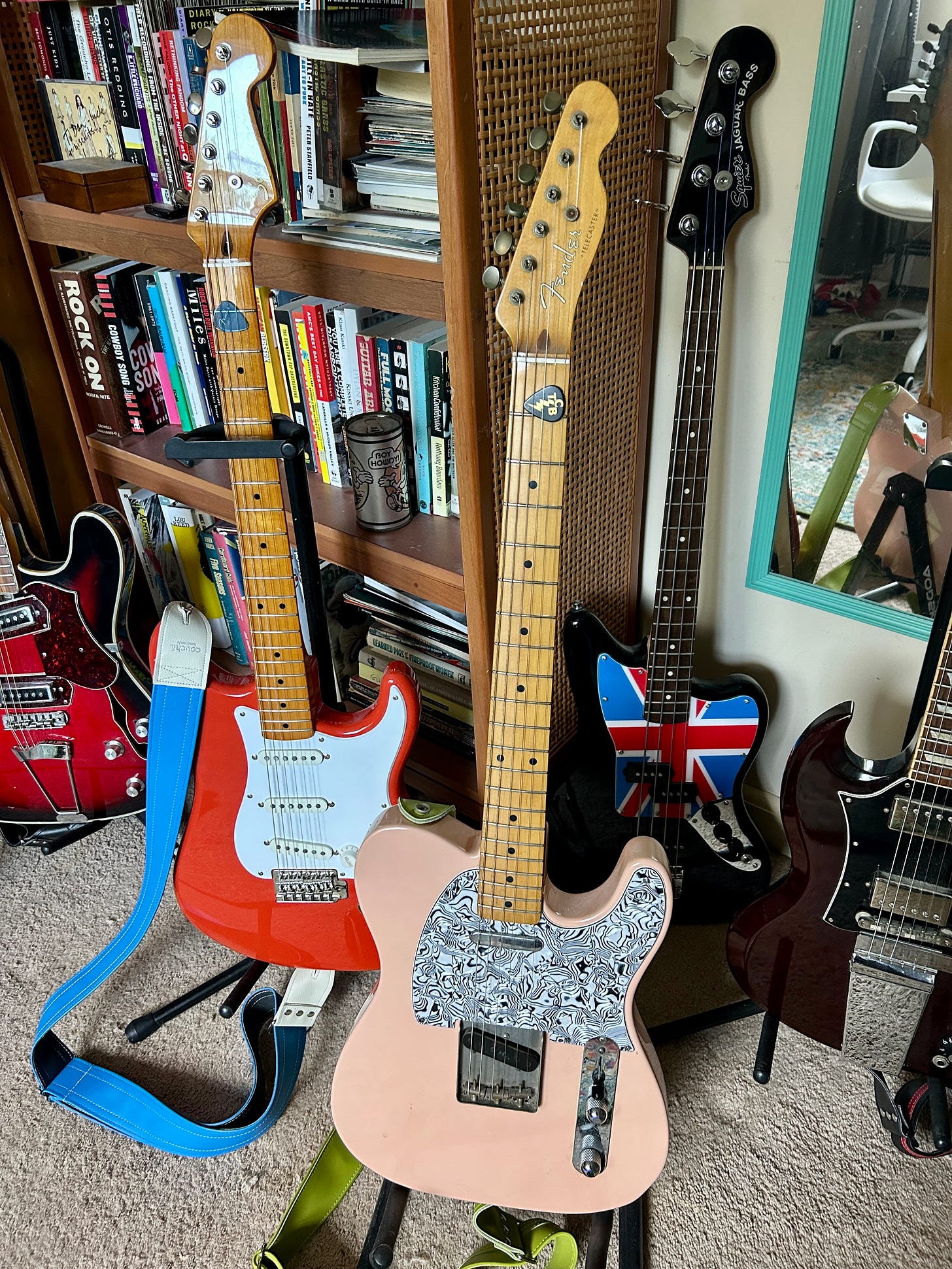
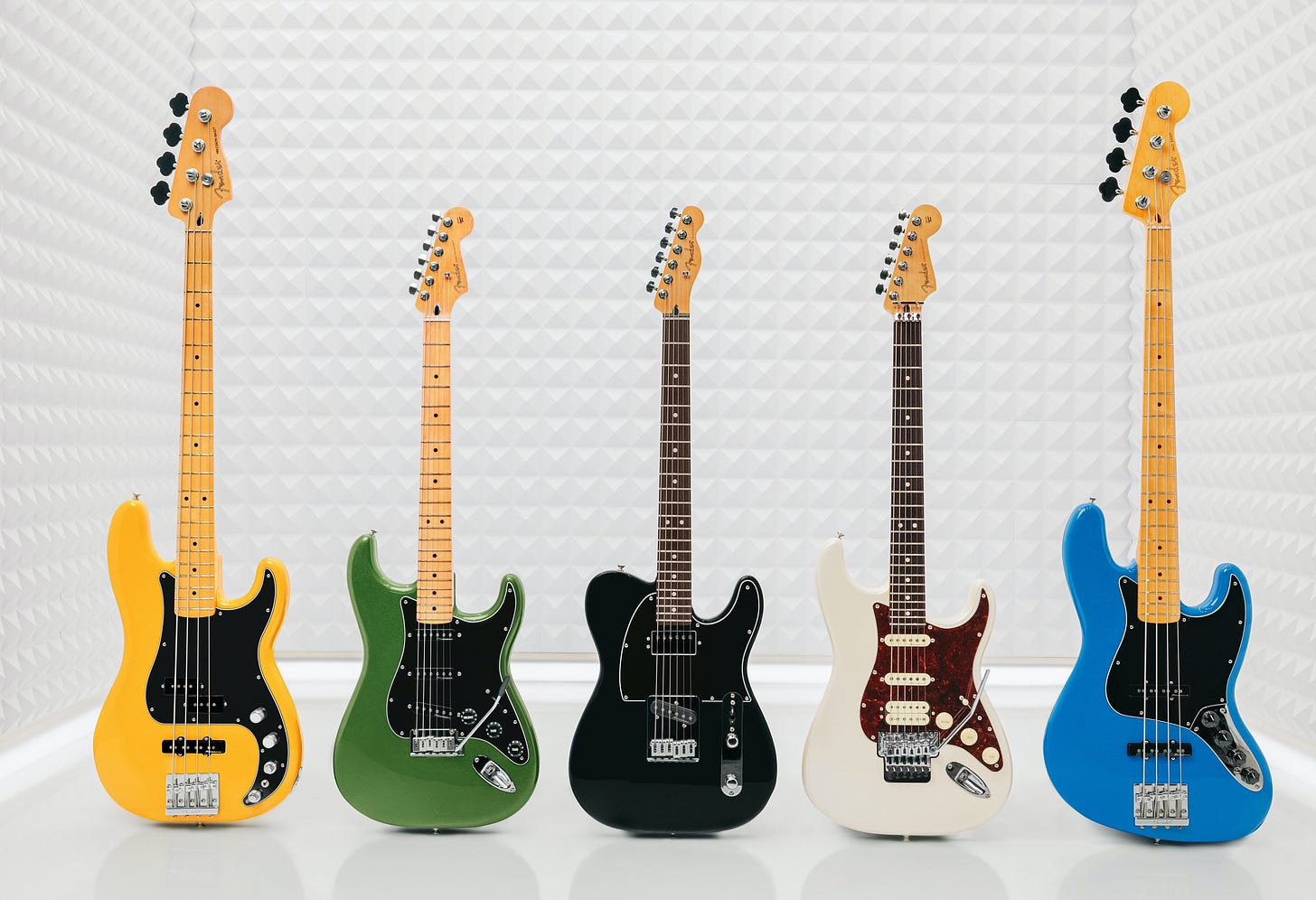

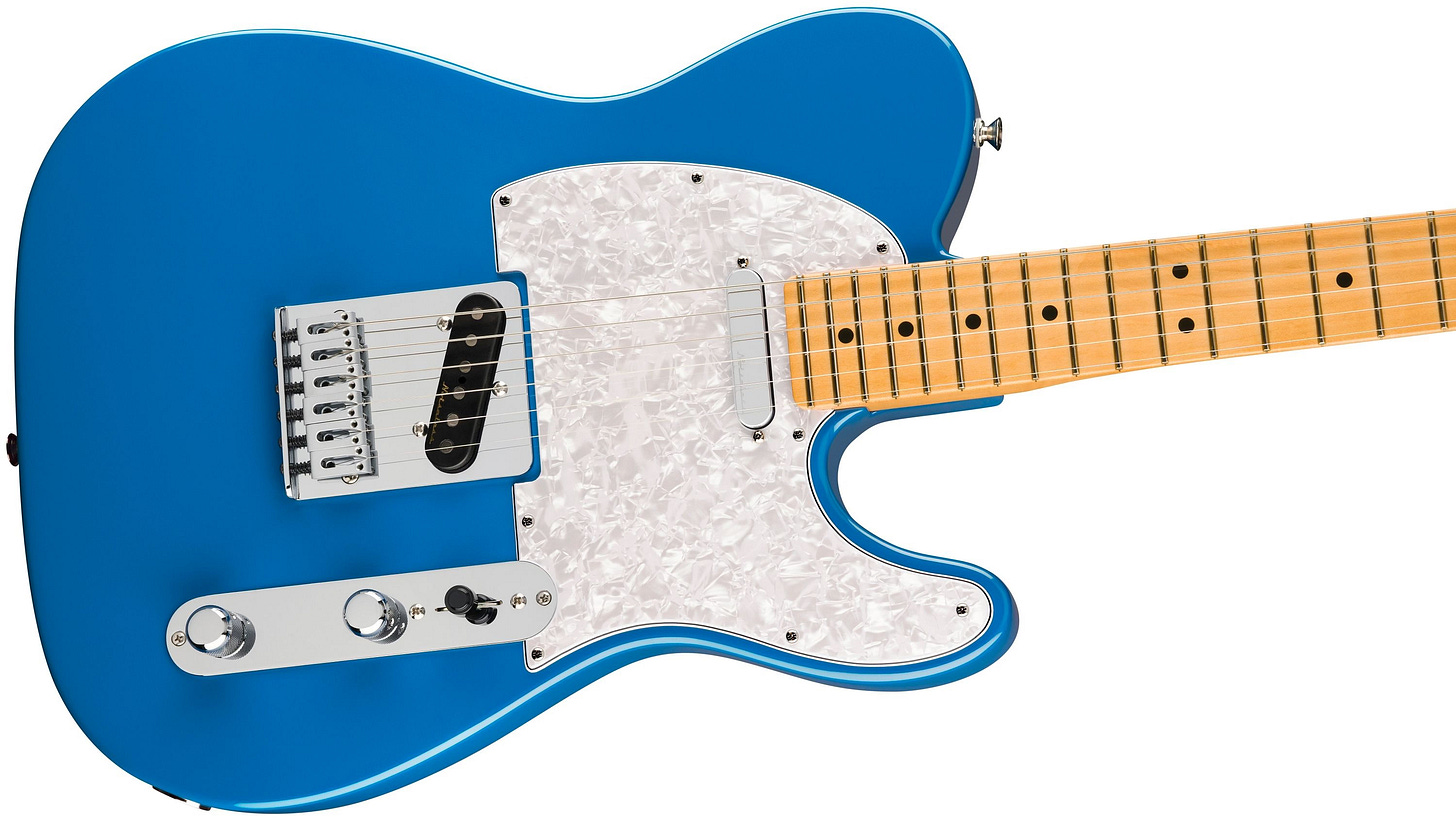

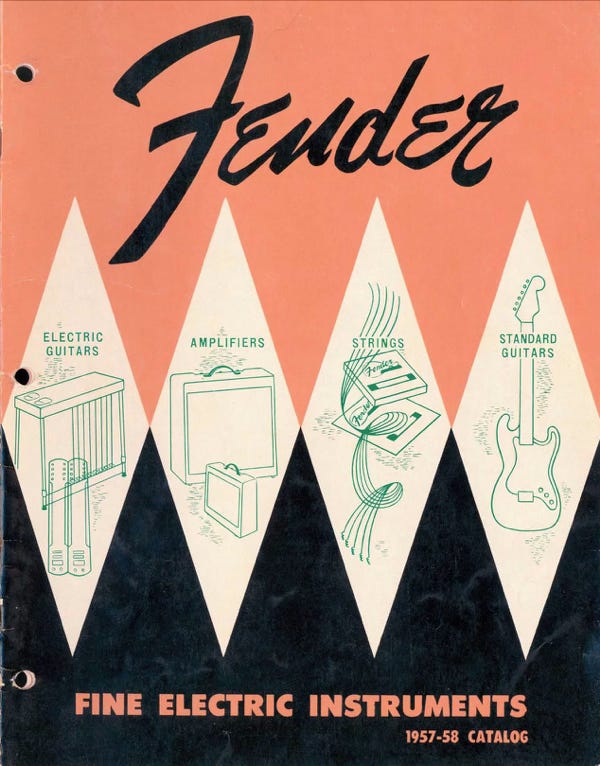
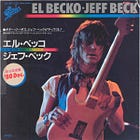


Dude - I did the same thing with the amp jury-rig before getting a proper amp, albeit even more crudely (if that's possible) by plugging into the MIC jack on a component stereo. I had no idea what 'impedance' was or whether things would start smoking. All I knew was that the plugs & jacks fit!
I remember Fender had the 'Lead I' & 'Lead II' guitars in the early 80s and my buddy had one - I thought those were super cool - kind of a more relaxed strat body style and very playable with more limited pickup options. Hey, if they were good enough for Steve Morse from Dixie Dregs they must be cool, right? I'd love to get my hands on either one of those someday.
Great read, as always - rock on!
I don’t know how you found a photo of a Wieners Circle sign that just, like, advertised product, but I have to tell you that I always love reading what you have to say and I loved reading this in particular because it is hard to find any discussion of guitar mods that isn’t dudes duding out trying to make absolutely damn certain they sound like they’re talking over my head.